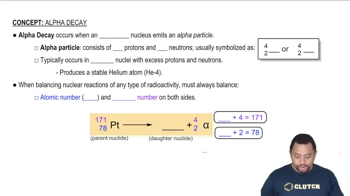Here are the essential concepts you must grasp in order to answer the question correctly.
Nuclear Reactions
Nuclear reactions involve changes in an atom's nucleus and can result in the formation of new elements. In the context of the question, a nuclear reaction occurs when calcium ions collide with californium, leading to the synthesis of a superheavy element. Understanding how to balance nuclear equations is crucial, as it ensures that the number of protons and neutrons is conserved during the reaction.
Recommended video:
Alpha Decay
Alpha decay is a type of radioactive decay in which an unstable nucleus emits an alpha particle, consisting of two protons and two neutrons. This process decreases the atomic number by two and the mass number by four, resulting in the formation of a new isotope. Recognizing how alpha decay affects the identity and stability of isotopes is essential for predicting the products of nuclear transmutation.
Recommended video:
Isotopes
Isotopes are variants of a chemical element that have the same number of protons but different numbers of neutrons, leading to different mass numbers. The question requires identifying the isotope formed after a series of alpha emissions, which involves calculating the changes in atomic and mass numbers. Understanding isotopes is fundamental in nuclear chemistry, particularly in the context of decay processes and their applications.
Recommended video:
 Verified step by step guidance
Verified step by step guidance

